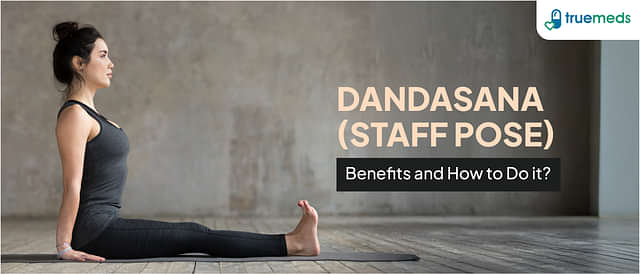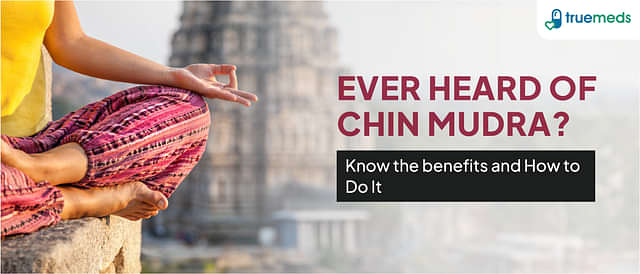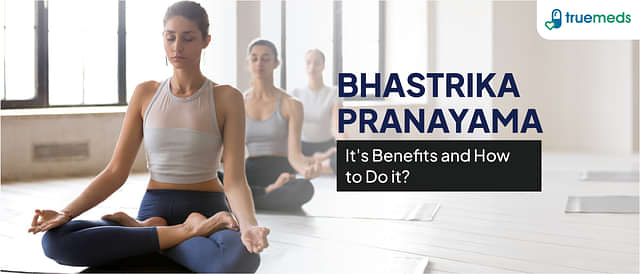Dhanurasana (Bow Pose): Benefits, Step-by-Step Guide, and Safety Tips
Last updated on : 01 Dec, 2025
Read time : 7 min
What is Dhanurasana?
Dhanurasana is a foundational yoga pose that requires a blend of strength, flexibility, and focus. It gets its name from two Sanskrit words , ‘Dhanu’, meaning bow, and ‘Asana’, meaning posture or seat. As the name suggests, while performing this posture, your body mimics the shape of a bow. Your torso and legs represent the body of the bow, while your arms serve as the string.
The Dhanurasana may seem challenging initially, but with mindful practice, you’ll be able to master it over time. Remember, patience and consistency are key. This powerful back-bend offers several physical and mental health benefits.
Performing Dhanurasana: Step-by-Step Instructions
Performing the Dhanurasana involves a series of steps that should be followed carefully to achieve proper form and gain maximum benefits.
- Lie on your stomach: Position yourself flat on your belly with your feet apart at a hip-width distance and arms resting by your sides.
- Bend your knees and reach back: Gently bend both knees and reach back with your hands to hold onto your ankles. If grasping the ankles is difficult, use a yoga strap (dharma mitt) around the ankles.
- Inhale and lift: As you breathe in, gently lift your chest off the ground and simultaneously pull your legs upwards and back. This action forms a bow shape with your body. Focus on lifting the thighs off the floor, keeping the knees hip-width apart.
- Maintain the posture: Ensure that you maintain your gaze forward and keep your breathing steady throughout the pose. Avoid crunching the neck.
- Hold and release: Retain the pose for about 10-20 seconds, then exhale and gently lower your chest and legs back to the ground, releasing your ankles.
Practising yoga under the guidance of a qualified instructor is crucial, especially when attempting poses such as Dhanurasana. As a powerful backbend, it requires meticulous technique and preparation to avoid any strain or injury. Perform this pose slowly and mindfully, especially if you are new to backbends.
Essentials for Practising Bow Pose (Dhanurasana)
- Yoga Mat: Having a good quality, non-slip yoga mat is crucial. It provides the grip necessary to hold the pose without slipping.
- Yoga Blocks: These can be exceptionally useful for beginners. They assist in maintaining chest lift and alignment during the initial stages.
- Yoga Strap: This is a handy tool for those who may struggle to grasp their ankles directly.
- Spacious Environment: Ensure that you have a clean, clutter-free area to practice. This will ensure your safety and allow you to focus better.
- Comfortable Clothing: Choose flexible and breathable clothing that allows for ease of movement and doesn’t restrict your posture.
- Warm-up: Before jumping into Dhanurasana, it’s essential to engage in gentle warm-up exercises. Poses like the Cat-Cow Pose (Marjaryasana-Bitilasana) and Cobra Pose (Bhujangasana) help prepare your spine for the deep backbend in Dhanurasana.
- Cool Down: After practising Dhanurasana, don’t forget to cool down. A counterpose like Child’s Pose (Balasana) or a gentle supine twist helps relax your body and mind, preventing any strain or injury.
Health Benefits of Practising Dhanurasana
Practising Dhanurasana regularly can have several impressive benefits on your physical and mental health.
- Strengthens Core and Back Muscles: Dhanurasana may help strengthen the muscles of the back, abdomen, and shoulders, promoting overall stability and endurance [1].
- Improves Spinal Flexibility: This pose can help improve flexibility in your spine, neck, and shoulders. It’s a great way to alleviate tension and stiffness in these areas. Regular backbends are associated with increased spinal range of motion.
- Stimulates Abdominal Organs: The deep compression of the abdomen in this pose may stimulate your digestive organs, liver, and pancreas. This abdominal massage may aid digestion and relieve constipation. Limited studies suggest that certain yoga asanas, including backbends, may positively influence metabolism and organ function [2].
- Enhances Respiratory Function: Dhanurasana may help open the chest, improve lung capacity, and support respiratory function [3]. The opening of the chest allows for deeper, fuller breaths, potentially enhancing oxygen flow throughout the body.
- Promotes Good Posture: Regular practice can improve your posture by strengthening the muscles that support your spine. This may reduce the risk of back pain and improve alignment.
- Reduces Stress and Anxiety: As a backbend, the pose is stimulating and can help relieve stress, fatigue, and mild depression [1]. It encourages emotional balance by activating the heart and solar plexus chakras.
Incorporating Dhanurasana into your regular yoga routine can significantly contribute to your physical health, emotional stability, and overall well-being.
Tips for Safe and Effective Dhanurasana Practice
- Engage Your Core: During the pose, activating your core muscles is crucial as it provides stability and support for your lower back, preventing any undue strain.
- Focus on the Hips: Try to keep your thighs lifted and the knees no wider than hip-distance apart; focusing on the lift from the hips, rather than straining the lower back, helps deepen the pose safely.
- Breathe Deeply: Your breath is a key part of the practice. Focusing on deep, steady breaths can help maintain balance and deepen the stretch in Dhanurasana. Never hold your breath in the pose.
- Listen to Your Body: It’s crucial that you pay attention to how your body feels during the pose. If you experience any sharp pain or discomfort, ease out of the pose immediately and adjust your position.
- Modify as Needed: Remember, yoga is not about forcing postures but about finding a variation that suits your current level of flexibility and strength. If gripping the ankles is difficult, use a yoga strap or only lift the chest (a modified Cobra/Shalabhasana).
Precautions and Contraindications of Dhanurasana
While Dhanurasana offers numerous benefits, there are certain precautions and contraindications to keep in mind. Always consult a healthcare professional before starting a new exercise regimen, especially if you have pre-existing medical conditions.
- Pregnancy: Pregnant women should strictly avoid this pose, especially during their later trimesters, due to potential pressure on the abdomen.
- Spinal Injuries: Those with a history of severe spinal injuries, herniated discs, or chronic back pain should avoid this pose or attempt only after consulting their doctor or physical therapist.
- Abdominal Issues: Individuals with recent abdominal surgery, hernia, or peptic ulcers should avoid Dhanurasana due to the intense abdominal pressure.
- High or Low Blood Pressure: People with uncontrolled high or low blood pressure should approach this pose with caution or avoid it, as backbends can affect blood flow.
- Neck or Wrist Issues: If you have neck, wrist, or ankle injuries, be cautious since this pose requires gripping the ankles and maintaining a neutral neck position. Avoid straining the neck by looking too far up or down.
Frequently Asked Questions (FAQs)
What is the best time to do Dhanurasana?
The optimal time to perform Dhanurasana, or bow pose yoga, is in the early morning, ideally on an empty stomach. If done later in the day, wait 3–4 hours after a heavy meal.
What are the restrictions of Dhanurasana?
The contraindications for Dhanurasana include pregnancy, recent surgery, hernia, ulcers, and severe back problems. Always consult your doctor before starting new exercises.
Does Dhanurasana reduce belly fat?
Dhanurasana can help tone and strengthen abdominal muscles, supporting core strength and metabolism. However, it should be combined with a calorie-controlled diet and regular cardiovascular exercise for significant fat loss [1].
Which disease is prevented by Dhanurasana?
Dhanurasana is not a direct cure or preventative measure for any specific disease. It may aid in managing symptoms related to digestive issues and can support general well-being, which is beneficial for people managing various conditions like early-stage diabetes [2].
References
[1] Yeung, A., Tou, W., Chung, M., Ng, T., & Ziea, E. (2018). Therapeutic potential of yoga in the management of pain: A systematic review and meta-analysis. Frontiers in Physiology, 9, 1092. https://doi.org/10.3389/fphys.2018.01092
[2] Innes, K. E., & Selfe, T. K. (2014). Yoga for adults with type 2 diabetes: a narrative review of the clinical research. International Journal of Yoga Therapy, 24(1), 27-44. https://doi.org/10.17761/ijyt.24.1.72506m566270v34p
[3] Makwana, K. (2011). Yoga practice for asthma and quality of life. Journal of Complementary and Integrative Medicine, 8(1). https://doi.org/10.2202/1553-3840.1492
Disclaimer
Our healthcare experts have carefully reviewed and compiled the information presented here to ensure accuracy and trustworthiness. It is important to note that this information serves as a general overview of the topic and is for informational purposes only. It is not intended to diagnose, prevent, or cure any health problem. This page does not establish a doctor-patient relationship, nor does it replace the advice or consultation of a registered medical practitioner. We recommend seeking guidance from your registered medical practitioner for any questions or concerns regarding your medical condition.
Popular Articles
Recommended Articles
Recent Articles
Company
About UsHealth ArticleHealth StoriesHealth LibraryDiseases & Health ConditionsAyurvedaUnderstanding Generic MedicinesAll MedicinesAll BrandsNeed HelpFAQSecuritySubscribe
Registered Office Address
Grievance Officer
Download Truemeds
Contact Us
Our customer representative team is available 7 days a week from 9 am - 9 pm.
v4.10.0
2025 - Truemeds | All rights reserved. Our content is for informational purposes only. See additional information.
Our Payment Partners














































